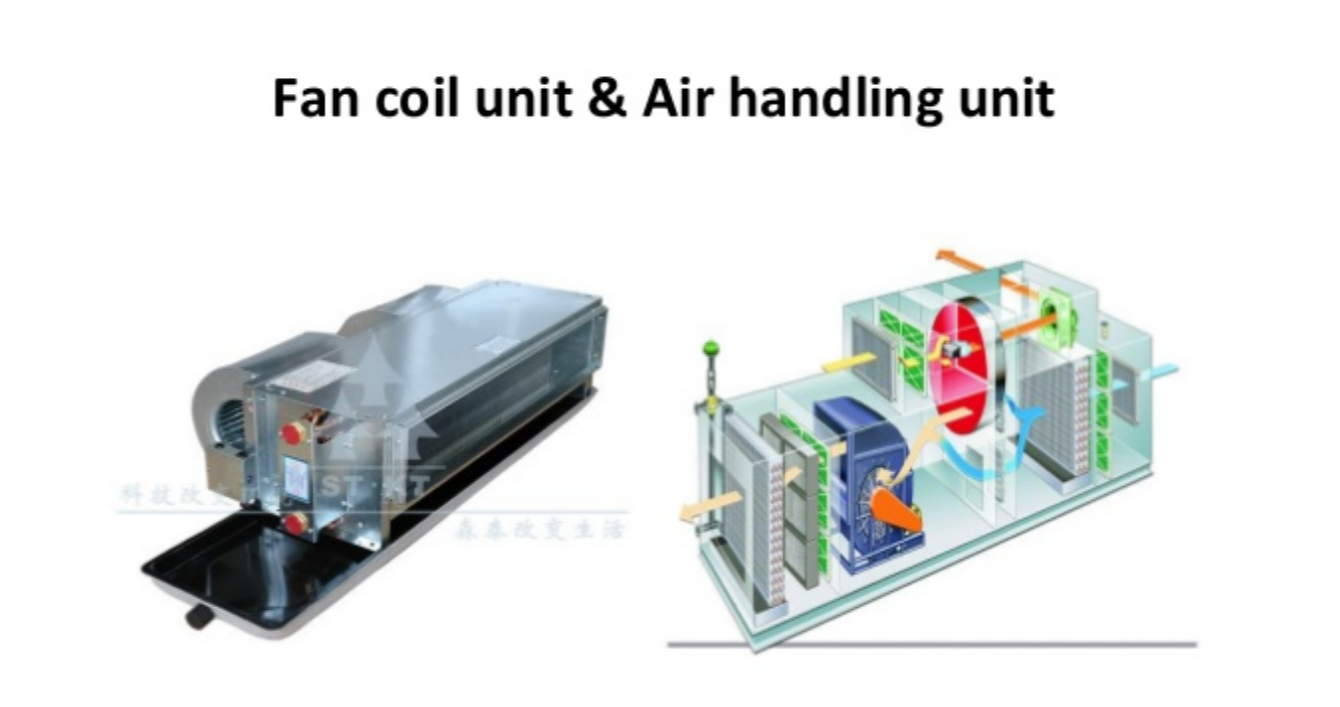What’s the difference between Induction units and Fan Coil units?

Induction units and fan coil units are the most common solutions for commercial buildings’ decentralized air conditioning devices. Nevertheless, both have distinct benefits and drawbacks. This article aims to review both units’ technical and economic differences for the cooling of commercial buildings.
Induction units vs. Fan Coil units
Both induction and fan coil units are installed below the suspended ceilings to match the heating and cooling loads of each cabin in a commercial building.
Induction units – Directly attached to the air duct system, induction units allow air to flow in the entire space through nozzles. The air temperature is set in the heat exchanger and resupplied into the rooms with the primary air through the air outlet grille. Read more about induction unit.

Fan coil units – The supply outlet is placed in the dropped ceiling with fan coil units. The air in the cabin gets in through the fan by way of a shadow gap in the ceiling. The temperature adjustment is made before it is transferred back into the room.

Technical comparison
Induction Units and Fan Coil Units
With induction units, higher external pressure causes higher power uptake through the central ventilation unit fans. Moreover, the portion of primary air that meets the cooling load is higher than with the fan coil units. The amount of air required to eliminate impurities in the air is exceeded upto a large extent, further harming energy consumption.
Fan coils with wet cooling are often utilized in HVAC systems to acclimatize spaces like hotel rooms. The fan coils generate higher cooling and heating output using a fan, resulting in the fan coil units requiring lesser space. People nowadays build smaller cabins in their offices. The fan coils are distinctively beneficial in smaller rooms.
Energy Usage
The electrical energy requirement of an air handling unit is primarily higher with induction units than with fan coils. The reason is the volume of flow the system needs is higher when an induction unit is used. Also, the pressure loss rises with the same dimensions of the air duct. The space needed and material costs also increase with the increase in air ducts. The only reason for the notable variance in the energy requirement is the higher air volume required from induction units than the lower air volume needed to release the pollutants and humidity.
Induction units can probably function with a higher air volume without the need for the room being occupied. The high power consumption is created through the centralized ventilation unit in a structure operating induction units.
Heating Energy Requirement
The heating energy requirement of fan coils and induction units doesn’t have any significant difference. Nevertheless, the air handling unit’s energy requirement is comparatively higher with induction units due to the increased volume of the system flow. The volume of the external air is raised by the volume of system air heated by the heater in a centralized air-conditioning unit.
Cooling Energy Requirement
The outcome of the electrical energy requirement in an air handling unit is aired in the cooling energy requirement. As assumed, the primary air flows in the pre-conditioned room. The increased cooling output is supplied to the induction units through the air handling unit due to the higher air volume, irrespective of whether the cooling outlet is needed. Also, it is possible that the exterior air gets cold in the centralized ventilation unit and however, reheats in the room as required.
Difference between air handling unit (AHU) vs. fan coil unit (FCU)
Both air handling units (AHU) and fan coil units (FCU) are integral components in an HVAC system. Ultimately, it is an acronym that outlines various systems of heating, ventilating, as well as air conditioning. AHU completely differs from FCU.
Usually, the air handling unit is closely connected with a central HVAC system; simultaneously, the fan coil unit can operate or get installed itself. However, the AHU is utilized to ventilate a whole building, and when we talk about FCU, it is used in smaller and mostly the local building. Not to mention, AHU is an extensive HVAC system, whereas FCU is said to be the smaller version of AHU. In this sense, the FCUs can be named as the terminal units.
The magnitude of the air handling unit utilities the air from the external environment. It then treats the air and allows it to make its way inside the vicinity with individual ducts. Fan coil unit, on the other hand, only circulates the internal air. FCU, usually, does not have any duct system. However, it is sizeably smaller and is made up of a usual coil and fan.
Certain features of the air handling unit are not available in any fan coil unit. AHU consists of various sections for humidifying and even reheating. FCU, on the contrary, don’t have any such sections. Probably, the only benefit with FCU systems is that it often can handle water, whereas the AHU system handles air.
Furthermore, air handling units can probably have multiple blowers or fans installed in the system. Fan coil units have a distinct technique. FCUs are smaller in size. However, the fans are often fixed in the same place as the unit itself. As a result, you might experience a minor awkward noise within the vicinity.
Investment, Maintenance, and Repair
Regarding the investment cost, the accessories are also to be considered, including safety equipment, the outlet grille, and the activators and values. The cost of fan coil units is comparatively higher than that of the induction units due to the lower number and smaller size of the rooms. The charges levied for filter and filter replacement are the additional costs. Induction units are often available without filters. For FCUs, no filter is needed. You can avoid the FCUs’ replacement costs by using regenerative filters.
Besides, if we calculate the overall cost with the inclusion of accessories, the induction units will cost higher than the FCUs. The more significant primary air volumes with induction units, hurt the overall investment cost for the ductwork, the AHU, and the room reconstruction is done to house the ductwork. However, the system’s overall charge created with induction units is higher than the system designed with FCUs.
Wrapping Up
Induction units are always required to have a definitive comparison between two systems. This further results in considerable differences between energy usage and investment costs owing to the increased energy consumption of the ventilation unit with induction units. Subsequently, the expenses for the wear parts, like, for example, the fan, don’t let the overall cost of FCUs surpass the cost of the induction unit system over the period it is monitored.









